Samsung, Sony, LG and others are producing commercial microLED panels, mostly for ultra-premium, signage and commercial applications. The ultra-large size displays are made from small microLED modules, seamlessly tiled together.
MicroLED technology makes it possible to connect two tiles in a way that retains exactly the same pixel pitch even at the tile connection (this is something that is challenging to do with OLED or LCD displays). When the displays are active, it is indeed very difficult to spot the seam. When the display is completely black however, this is not the case, and the seams are visible, and the different modules (which are never 100% aligned) reflect light a bit differently which creates a mosaic-like image.
If you look at the two photos published by Samsung recently, you can see that the camera's flash light, when it bounces back from the screen, shows the individual tiles.
The two images show Tae-yong Son, Vice President responsible for the microLED team at Samsung Electronic's Visual Display Business Unit.
We haven't heard any complaints regarding the visible seams at Samsung's MicroLED TVs, but it is interesting to see them so clearly in these photos, for people that have not yet seen a microLED TV in real life. Companies are developing technologies that will make the seams less visible.
In any case, it is not clear whether companies, Samsung and others, have a path for reducing tiled microLED TV panels to a price point that will compete in price with current OLED high-end TVs, at standard sizes (55 to 83 inch).



